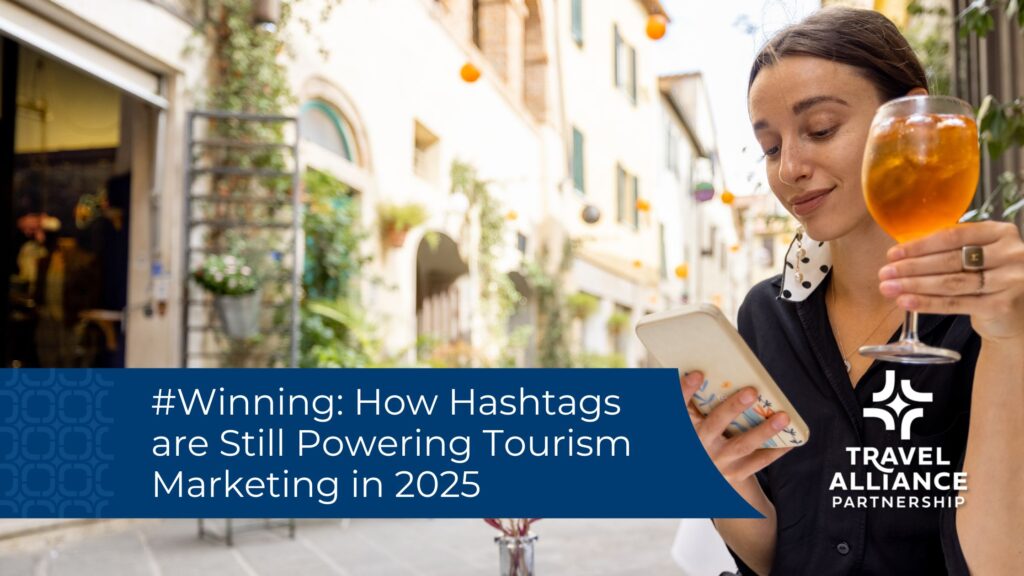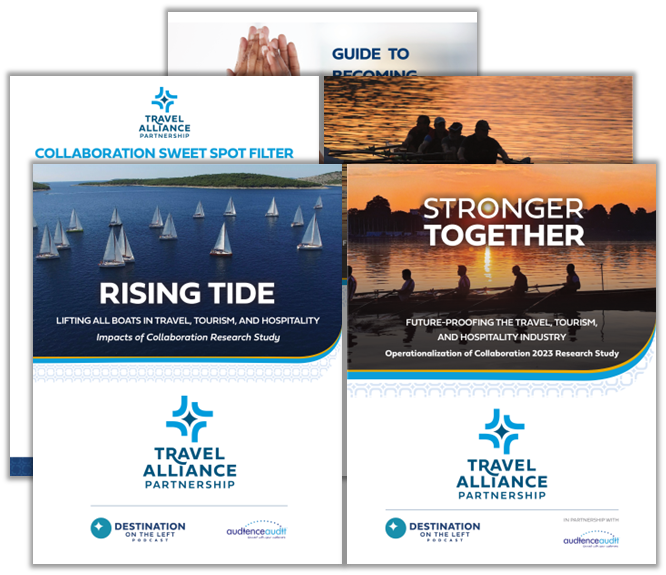#Winning: How Hashtags are Still Powering Tourism in 2025
Hashtags may have started as a simple way to organize online conversations, but they’ve evolved into powerful tools for storytelling, discoverability, and community-building. In 2025, they’re far from outdated – in fact, posts that include hashtags still see significantly higher engagement rates across platforms. According to recent data, social posts with at least one hashtag average 12.6% more engagement than those without. When using hashtags for the tourism industry – destination marketing organizations (DMO’s), tour operators and tourism brands – that kind of visibility can mean more user-generated content, stronger brand awareness and ultimately, more travelers.
But here’s the real question:
Are you using them strategically?

Why Hashtags for Tourism Still Matter in 2025
Despite being around for well over a decade, hashtags remain one of the most effective ways to bridge the gap between inspiration and action in tourism marketing. In a world full of overflowing content, they help aspiring travelers cut through the noise and discover real stories, authentic experiences, and hidden gems shared by others just like them.
Travelers might be dreaming up their next vacation or already mid-road trip, and hashtags offer a lens into what’s happening in the destination in real time. They surface the best of your region, from epic sunsets to secret coffee shops, often told from the traveler’s perspective; a kind of storytelling no ad can buy.
Hashtags are everywhere. When used correctly, they extend your reach, increase engagement, and create pathways for connection.
What Makes a Great Tourism Hashtag?
Not all hashtags are created equal. In the tourism industry, the best performing hashtags typically fall into four categories:
- Branded hashtags are unique to your destination or organization, think #VisitSavannah or #GoSoIN. These build brand awareness and serve as a digital filing cabinet for user-generated content (UGC).
- Community hashtags are those used widely across the industry, like #Wanderlust or #TravelTuesday. They help you tap into existing conversations and expand your reach.
- Campaign hashtags are tied to specific initiatives or promotions, such as #SkiFLX for a winter getaway or #SiptheValley during wine season.
- Trending hashtags change by the day or week and give you an opportunity to join bigger conversations in real time – like #ThrowbackThursday or #NationalTravelandTourismWeek
The key is to mix and match, pair something branded with something familiar to increase your visibility and authenticity to potential travelers.
Aligning Hashtags with your Tourism Goals
Your hashtag strategy should be more than an afterthought—it should be aligned with your marketing objectives. Ask yourself: what is your destination trying to accomplish?
- Want more engagement? Join in on trending conversations like #TravelTuesdays or #BucketList.
- Looking for user generated content (UGC)? Promote branded hashtags across signage, itineraries, and visitor centers like #MyMyrtleBeach.
- Launching a campaign? Create a custom tag such as #RoamtheEmpire and ask partners to help amplify.
- Trying to build community? Tap into passion points like #FamilyTravel or #RoadTripReady.
When your hashtags are tied to clear goals, it is easier to measure performance and get internal buy-in from stakeholders.
Hashtag Pitfalls to Avoid
Even in 2025, we still see these classic mistakes:
- Disuse: If you’re not using hashtags, you’re missing low-hanging fruit for visibility and searchability.
- Misuse: Avoid over-branding or inventing niche hashtags no one is searching for. Avoid trailing hashtags, the more concise the better.
- Overuse: More is not always better. Use 3-5 highly relevant hashtags on most platforms. On Instagram, group extras with clean formatting (such as line breaks or in the comments) on Twitter/X stick to 1 or 2 to avoid clutter.
Think Beyond the Post
Smart hashtag strategy isn’t just about visibility—it’s about alignment. When used thoughtfully, hashtags for the tourism industry reinforce your brand’s voice, connect your social media efforts to broader campaign goals, and support larger content ecosystems like blogs, newsletters, and influencer collaborations. They help carve out space in a noisy digital landscape, ensuring your message reaches the right audience at the right time. In short, hashtags aren’t a standalone tactic—they’re part of a well-oiled content strategy, helping brands move from passive posting to purposeful storytelling.
Hashtags aren’t a relic of the early 2010’s, they are still a strategic tool that continues to shape how travelers find, engage with, and remember destinations. When used with intention, they can amplify your story telling, build brand loyalty and keep your destination in part of the broader tourism conversation.
Author
Related Posts
How Curated Experiences Can Help Your Tourism Marketing
In years past, travelers may have been satisfied to see sites like the Eiffel Tower or Colosseum; now they want to get behind the scenes,...
Marketing for Group Travel: Building Solid Relationships with Tour Operators
Group travel is a significant segment of the tourism market, and if you want to see those buses pulling up to the curb and filling…
